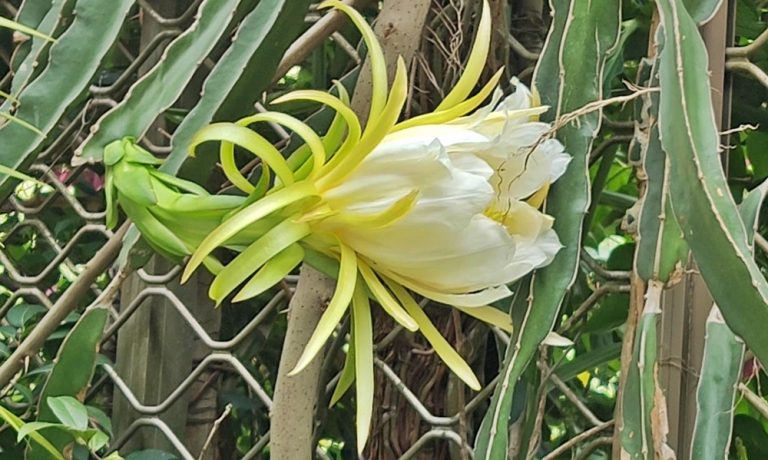Known for its fascinating fiery-red look, dragon fruit (also known as pitaya or pitahaya), is a popular tropical fruit belonging to the family Cactaceae. Believed to be indigenous to Central America, it is a vining cactus with long and flattened leaves and can be found in all tropical regions around the world.
Please watch the following video about dragon fruit.
The plant is also referred to as “lady of the night,” “moonflower,” or “one-day wonder,” since its flowers will wither before dawn. At dusk, beautiful flowers are produced by a climbing cactus and are pollinated by nocturnal pollinators, such as moths and bats, but some varieties are self-pollinating. Nevertheless, it is fun to do hand pollination with a brush pen at midnight yourself.

Unique properties of dragon fruit
The plants can produce fruits after one year of establishment and can be productive for more than 20 years. This exotic fruit comes from different species, and the most commonly seen varieties have either white flesh or red flesh. Both of them are available year-round because each plant can even pollinate up to six times a year.

White-fleshed dragon fruit
The white-fleshed variety is the most commonly grown type of pitaya. With vibrant pink skin, it has a semi-sweet white flesh spotted with black seeds. It tastes like a melon and is tastier when chilled. However, its flavor is less sweet than the red-flesh variety.

Red-fleshed dragon fruit
The appearance of the red-fleshed fruit is almost identical to the white-fleshed variety, but it is red inside. The pulp has the texture of kiwi fruit, with black edible seeds.

The inside of the immature fruit is actually white, but it gradually turns red during the process of ripening. It is said that the dried red fruit has up to 10 times the nutritional benefits of fresh fruit. They can also be used as a natural dye or colorant.

Health benefits
The fruit is rich in essential nutrients. According to research, each serving of 100 grams (3.5 ounces) contains 60 calories, 1.2 grams of protein, 13 grams of carbs, 3 grams of fiber, 3 percent of the recommended dietary intake (RDI) of Vitamin C, 4 percent of the RDI of iron, 10 percent of the RDI of magnesium, without any fats.

In particular, it is extremely low in cholesterol, and the seeds in the fruit are loaded with omega 3 fatty acids, which can help prevent heart disease and stroke. Other benefits are as follows.

A boost for the immune system
The fruit contains Vitamin C, which can help the human body fend off germs, bacteria, and particularly free radicals, which are unstable molecules that cause cell damage.

Aid the digestive system
The fruit is an excellent source of fiber. Its dietary fiber can benefit gastrointestinal health. It is also an excellent natural remedy for constipation, as it has a good laxative effect.

Protect the heart
The fruit is rich in flavonoids, which are antioxidant pigments that can protect human cells from damage by free radicals. And its edible seeds contain omega-3 and omega-9 fats, which are good for the heart.
Helps to prevent cancer
The fruit contains antioxidants called hydroxycinnamates, which can help reduce cancerous cells in the human body. In particular, the red-fleshed fruit contains lycopene, which is a red carotenoid pigment also present in tomatoes, berries, and other fruits. It is beneficial in protecting against chemical and natural toxins.

Helps reduce the risk of diabetes
The fruit contains high amounts of fiber that maintains blood sugar levels and prevents further medical conditions associated with diabetes. The flavonoid in red-fleshed dragon fruit can also help control glucose levels for patients with Type 2 diabetes.
Maintains bone structure
Dragon fruit is loaded with essential minerals, in particular, potassium and calcium, which are of much help to maintaining bone structure. Potassium also plays a key role in regulating our fluid balance, muscle contractions, and nerve signals.

Protects the gut
The prebiotics contained in dragon fruit can promote the growth of two families of healthy bacteria in our gut: lactic acid bacteria and bifidobacteria, which are associated with a healthy gastrointestinal tract.
Promotes skin health
The vitamin C and antioxidants contained in dragon fruit can play a role in rejuvenating the skin by repairing cell damage. It may help reduce age spots, dry skin, wrinkles, and acne, as well as soothe sunburn skin. Therefore, eating these fruit regularly may result in a more youthful appearance.

Cooking dragon fruit flower recipes
Dragon fruit is a fascinating fruit. Apart from its nutritious flesh, its beautiful flower is also edible. Its young green buds are used as a vegetable. They can be sauteed or used to make soups and salads. They can also be stir-fried with beef, pork, or other ingredients. Additionally, its fried flower petals can be used as an accompaniment for meats and other main dishes.








